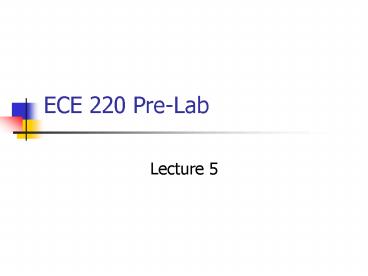ECE 220 PreLab - PowerPoint PPT Presentation
1 / 24
Title:
ECE 220 PreLab
Description:
Questions. Purpose? To introduce the analysis and design of RL and RC circuits ... Questions? The only stupid question is the one you didn't ask!!!! The End ... – PowerPoint PPT presentation
Number of Views:24
Avg rating:3.0/5.0
Title: ECE 220 PreLab
1
ECE 220 Pre-Lab
- Lecture 5
2
When and Where?
- Turn in to the Stockroom
- Due by 400 PM on Friday
3
Changes to Lab 5!!
- Page 1, Part 1b
C1 0.05 uF changes to C1 0.1 uF - Page 4, Part 4, All Frequencies
- 125 Hz changes to 100 Hz
4
Outline
- Purpose of the lab
- What to turn in
- Results you should expect
- Questions
5
Purpose?
- To introduce the analysis and design of RL and RC
circuits - To introduce the integrating op-amp circuit
- To introduce new PSpice skills
- Labeled nodes
- Initial conditions of Cs and Ls
- Switches
- New voltage sources
6
Part 1 Something like this
7
What to turn in?
- General expressions for V(t), IC(t), IR(t) in
terms of I1, R, C, Vo, and to - If necessary, give separate expressions for t lt
to- and t gt to - Printed schematic
- Plots for V(t), IC(t), and IR(t)
- Mark the values at t 0.3 ms
- Hand calculations using general expressions to
solve for V, IC, and IR at t 0.3 ms, and
comparison to PSpice - Brief explanation of the form of V(t), IC(t), and
IR(t) in terms of the capacitor characteristic at
t to and t infinity
8
What to expect?
9
Approach
- Use information on page 7 of the prelab to derive
your general expressions - When explaining the form of the plots, remember
- Capacitor acts like a short circuit before
charging - Capacitor acts like an open circuit when fully
charged
10
Part 2 Something like this
11
What to turn in?
- Printed schematic and plot
- The of the final value Vout reached at t 6 ms
- Printout of plot with VPWL changed
- The of the final value Vout reached after 5
time constants
12
Results?
13
Results for 5 time constants?
14
Part 3 Something like this
15
What to turn in?
- General expressions for IR(t), VL(t), and VR(t)
in terms of V1, R, L, and to - If necessary, give separate expressions for t lt
to- and t gt to - Printed schematic
- Plots of IR(t), VL(t), and VR(t)
- Mark values at t 0.3 ms
- Hand calculations using general expressions to
solve for I, VL, and VR at t 0.3 ms and
comparison to PSpice - Brief explanation of the form of IR(t), VL(t),
and VR(t) in terms of the inductor characteristic
at t to and t infinity
16
Results?
17
Approach
- Use information on page 7 of the prelab to derive
your general expressions - When explaining the form of the plots, remember
- Inductor acts like an open circuit before
charging - Inductor acts like a short circuit when fully
charged
18
Part 4 Something like this
19
What to turn in?
- Calculations for your design
- R1 must be a combination of standard resistor
values, with total resistance in the range 5k to
330k - C must be a single capacitor of standard value in
the range 0.01 uF to 1 uF - Printout of schematic with designed values
- Plots of input and output waveforms for
approximately 20 cycles - Value of R2 that stabilizes Vout and observations
- Plot of Vout with new R2
20
Results?
21
Approach
- Everything you need to solve this problem is on
page 8 of the prelab - To get the value of R2, you must iterate
different values for R2 until you get a stable
output with exactly the correct peak to peak
voltage - When you get it right, it will look similar to
the plot on the next slide
22
Results after R2 set correctly?
23
Questions?
- The only stupid question is the one you didnt
ask!!!!
24
The End
- Good luck and see you next time!!































